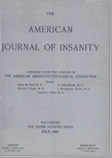Abstract
The Rorschach "Psychodiagnostik" test, consisting of ten symmetrical ink-blots, and its technique are briefly described. The test was administered to 87 feeble-minded children in Randall's Island, New York City. The response patterns of 69 are here reported. The principal results are:
"W" responses range slightly higher for this group than for Rorschach's feeble-minded. They vary regularly with certain mental ages, sufficiently so to differentiate for certain mental levels.
"F+." The mean and range is again higher than for Rorschach's group, but they are sufficiently close to be generally confirmatory of his findings. The mean of F+ tends to be lower at lower mental levels.
"A" responses. These were slightly lower for this group than for Rorschach's, but the range is generally confirmatory of his norms. The per cent A responses seems to vary with appearance of critical faculty on the part of the Randall's Island group. "Do." Only 20 of the 69 cases in this study showed Do responses, and its appearance seems to bear no relationship to mental level. It is therefore found not valid as an indicator of mental deficiency. In absence of Do, the present group's apperception type could not be D-Do, as Rorschach reports for his. But, 72.5 per cent of our cases showed a D-Dr apperception type.
The range of O responses for the Randall's Island group is approximately the same as established by Rorschach for his. However no account was taken, in the group here studied of O and O-, owing to the unsatisfactory norms for differentiating these two grades. There is an indication that originality and total productivity vary directly.
"M" responses. The mean M response for the 69 children was 0.75, and 38, or 55 per cent of these cases were without M. These results confirm Rorschach, although he reports no M responses at all for his defectives.
"C" responses. The C response mean was 3.70, a difference of 2.95 as compared with the mean M, and a D/SD diff. of 6.15. This is fully in accord with the relationship established by Rorschach.
The median C response for children found "affectively stable" is less than the median for those "affectively unstable." Thus there is a difference in the direction required according to Rorschach, but the difference is not statistically reliable.
While C responses vary with certain mental age levels, there is no correlationship between C response and the total mental age curve of our group, i. e., affectivity is not a regular function of mental age change.
Not enough of our cases showed S responses to test this concept.
The P response confirms Rorschach and Pfister as an index to sociality, since a D/PE diff. of a high degree of reliability was found between the median P of children helping on wards and all the rest.

